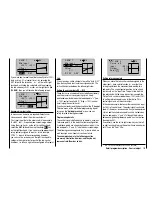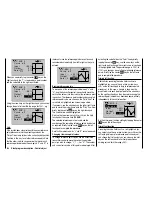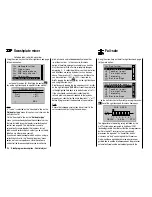
199
Detail program description - Control adjust
the model memories of the
mx-20
HoTT teacher
transmitter. The HoTT receiver of the model in question
must also be "bound" to the teacher transmitter, since the
latter ultimately controls the model, even in pupil mode.
ALWAYS ENSURE YOU SWITCH ON THE
mx-20
HoTT teacher transmitter FIRST BEFORE PLUGGING
THE CONNECTION CABLE INTO THIS UNIT. If you do
not, the RF module will not be enabled.
The
mx-20
HoTT teacher transmitter can be
connected to any suitable pupil transmitter, even
transmitters using the "traditional" 35/40 MHz range.
If the pupil-side connection does NOT utilize a two-
pole DSC socket, however, but a three-pole trainer
socket from the
Graupner
range (for example), then the
fundamental precondition for a correct connection
to a pupil transmitter is that the modulation type
PPM (18 or 24) must ALWAYS be confi gured in the
pupil transmitter, regardless of the modulation type
used in the teacher transmitter.
Pupil transmitter set-up
The model to be controlled by the pupil
must be
programmed completely
– i. e. with all its functions including
trims and any mixer functions – in one of the model
memories of the teacher transmitter. If present, the HoTT
receiver of the model in question must also be "bound" to
the
teacher
transmitter. In principle, however, an
mx-20
HoTT pupil transmitter can also be connected to a teacher
transmitter from the "traditional" 35/40 MHz range.
Almost any transmitter with at least 4 control functions
from previous and current
Graupner
series can be used
as a pupil transmitter. More detailed information can be
found in the RC main catalog and on the www.graupner.
de website.
If required, the pupil transmitter should be fi tted with the
connection module for pupil transmitters. This is to be
connected to the transmitter board in accordance with
the supplied installation instructions.
Information on the pupil modules required in each case
can be found in
Graupner's
RC main catalog and on the
www.graupner.de website.
The connection to the teacher transmitter is made using
the appropriate lead; see the following double page.
The control functions of the pupil transmitter MUST
act directly on the control channels, i. e. the receiver
outputs, without intermediary mixers.
If you are using an "
mc
" or "
mx
" series transmitter,
it is best to activate a free model memory with the
required model type ("Fixed-wing" or "Heli"). Assign the
model name "Pupil" and set up the stick mode (mode 1
… 4) and "Throttle min. forward/back" to suit the pupil's
preferences. All other settings are left at their default
values, however. If you have selected the "Helicopter"
model type, you must also set the throttle/ collective
pitch direction and idle trim on the pupil transmitter. All
other settings, including mixer and coupling functions,
are confi gured exclusively on the teacher transmitter,
which in turn transmits them to the model.
With "
D
" and "
FM
" type transmitters, you must also
check the direction of servo rotation and stick mode,
and adjust as necessary by swapping the corresponding
leads. All mixers must also be switched off or set to
"zero".
When assigning control functions, the usual conventions
must be observed:
Channel
Function
1
Motor throttle/collective pitch
2
Aileron/roll
3
Elevator/pitch-axis
4
Rudder/tail rotor
If you wish to transfer other control functions to the pupil
transmitter in addition to the functions of the two dual
axis sticks (1 … 4), access the
"Control adjust"
menu
on the pupil transmitter and assign transmitter controls to
the
inputs
that correspond to the control numbers
5 … 12
released on the teacher transmitter's "
Teacher/pupil"
menu.
Important:
If you should forget to assign a transmitter
•
control on the pupil side, then the affected servo
or servos will remain in the center position when
the transfer is made to the pupil transmitter.
The pupil transmitter must always be operated in
•
PPM mode, regardless of the RF connection type
used between the teacher transmitter and the model.
If the transmitter is connected using a DSC
•
socket on the pupil side,
ALWAYS
leave the
pupil transmitter's On/Off switch in the
"
OFF
"
position: this is the only way to guarantee that
no RF signal is sent from the pupil transmitter's
transmitter module , even after the DSC lead has
been plugged in.
Trainer mode operations
Both transmitters are connected to one another using
a suitable lead (see summary on next page): The plug
marked "
M
" (master) must be inserted into the socket
on the teacher transmitter, and the plug marked "
S
"
(student) into the pupil transmitter's socket. (Note that
not all leads may have such "M" and "S" labeling.)
Summary of Contents for mx-20 Hott
Page 41: ...41 Your notes...
Page 49: ...49 Your notes...
Page 55: ...55 Your notes...
Page 81: ...81 Your notes...
Page 85: ...85 Your notes...
Page 89: ...89 Your notes...
Page 99: ...99 Detail program description Control adjust...
Page 127: ...127 Detail program description Control adjust...
Page 131: ...131 Detail program description Control adjust...
Page 163: ...163 Detail program description Control adjust...
Page 191: ...191 Detail program description Control adjust...
Page 207: ...207 Detail program description Control adjust...
Page 228: ...228 Detail program description Control adjust...
Page 229: ...229 Detail program description Control adjust...
Page 251: ...251 Detail program description Control adjust...
















































